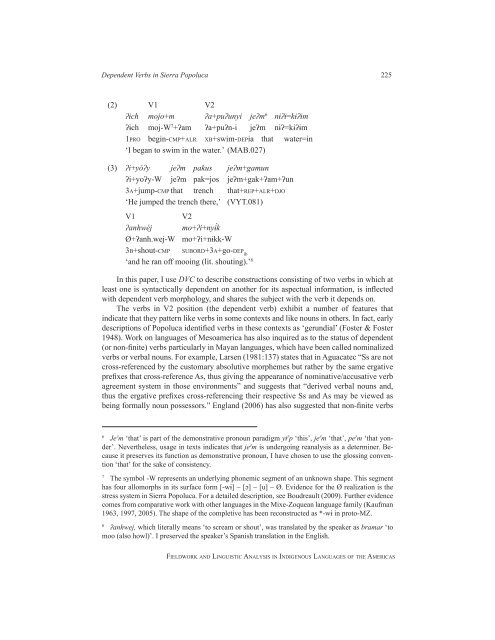Fieldwork and Linguistic Analysis in Indigenous ... - ScholarSpace
Fieldwork and Linguistic Analysis in Indigenous ... - ScholarSpace
Fieldwork and Linguistic Analysis in Indigenous ... - ScholarSpace
Create successful ePaper yourself
Turn your PDF publications into a flip-book with our unique Google optimized e-Paper software.
Dependent Verbs <strong>in</strong> Sierra Popoluca 225<br />
(2) V1 V2<br />
ʔɨch mojo+m ʔa+puʔunyi jeʔm 6 nɨʔɨ=kɨʔɨm<br />
ʔɨch moj-W 7 +ʔam ʔa+puʔn-i jeʔm nɨʔ=kɨʔɨm<br />
1Pro beg<strong>in</strong>-cmP+alr xb+swim-dePia that water=<strong>in</strong><br />
‘I began to swim <strong>in</strong> the water.’ (MAB.027)<br />
(3) ʔi+yóʔy jeʔm pakus jeʔm+gamun<br />
ʔi+yoʔy-W jeʔm pak=jos jeʔm+gak+ʔam+ʔun<br />
3a+jump-cmP that trench that+reP+alr+dJo<br />
‘He jumped the trench there,’ (VYT.081)<br />
V1 V2<br />
ʔanhwéj mo+ʔi+nyɨ́k<br />
Ø+ʔanh.wej-W mo+ʔi+nɨkk-W<br />
3b+shout-cmP subord+3a+go-deP ib<br />
‘<strong>and</strong> he ran off moo<strong>in</strong>g (lit. shout<strong>in</strong>g).’ 8<br />
In this paper, I use DVC to describe constructions consist<strong>in</strong>g of two verbs <strong>in</strong> which at<br />
least one is syntactically dependent on another for its aspectual <strong>in</strong>formation, is <strong>in</strong>flected<br />
with dependent verb morphology, <strong>and</strong> shares the subject with the verb it depends on.<br />
The verbs <strong>in</strong> V2 position (the dependent verb) exhibit a number of features that<br />
<strong>in</strong>dicate that they pattern like verbs <strong>in</strong> some contexts <strong>and</strong> like nouns <strong>in</strong> others. In fact, early<br />
descriptions of Popoluca identified verbs <strong>in</strong> these contexts as ‘gerundial’ (Foster & Foster<br />
1948). Work on languages of Mesoamerica has also <strong>in</strong>quired as to the status of dependent<br />
(or non-f<strong>in</strong>ite) verbs particularly <strong>in</strong> Mayan languages, which have been called nom<strong>in</strong>alized<br />
verbs or verbal nouns. For example, Larsen (1981:137) states that <strong>in</strong> Aguacatec “Ss are not<br />
cross-referenced by the customary absolutive morphemes but rather by the same ergative<br />
prefixes that cross-reference As, thus giv<strong>in</strong>g the appearance of nom<strong>in</strong>ative/accusative verb<br />
agreement system <strong>in</strong> those environments” <strong>and</strong> suggests that “derived verbal nouns <strong>and</strong>,<br />
thus the ergative prefixes cross-referenc<strong>in</strong>g their respective Ss <strong>and</strong> As may be viewed as<br />
be<strong>in</strong>g formally noun possessors.” Engl<strong>and</strong> (2006) has also suggested that non-f<strong>in</strong>ite verbs<br />
6 Je ʔ m ‘that’ is part of the demonstrative pronoun paradigm yɨ ʔ p ‘this’, je ʔ m ‘that’, pe ʔ m ‘that yonder’.<br />
Nevertheless, usage <strong>in</strong> texts <strong>in</strong>dicates that je ʔ m is undergo<strong>in</strong>g reanalysis as a determ<strong>in</strong>er. Because<br />
it preserves its function as demonstrative pronoun, I have chosen to use the gloss<strong>in</strong>g convention<br />
‘that’ for the sake of consistency.<br />
7 The symbol -W represents an underly<strong>in</strong>g phonemic segment of an unknown shape. This segment<br />
has four allomorphs <strong>in</strong> its surface form [-wɨ] ~ [ɔ] ~ [u] ~ Ø. Evidence for the Ø realization is the<br />
stress system <strong>in</strong> Sierra Popoluca. For a detailed description, see Boudreault (2009). Further evidence<br />
comes from comparative work with other languages <strong>in</strong> the Mixe-Zoquean language family (Kaufman<br />
1963, 1997, 2005). The shape of the completive has been reconstructed as *-wɨ <strong>in</strong> proto-MZ.<br />
8 ʔanhwej, which literally means ‘to scream or shout’, was translated by the speaker as bramar ‘to<br />
moo (also howl)’. I preserved the speaker’s Spanish translation <strong>in</strong> the English.<br />
fieldwork <strong>and</strong> l<strong>in</strong>guistic analysis <strong>in</strong> <strong>in</strong>digenous languages of the americas

















